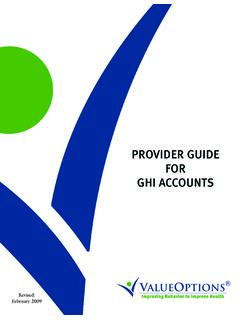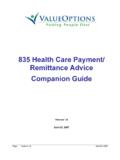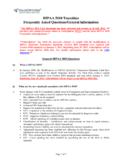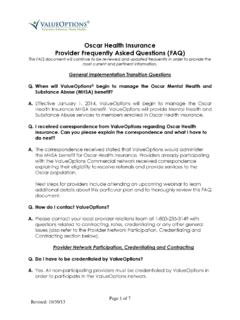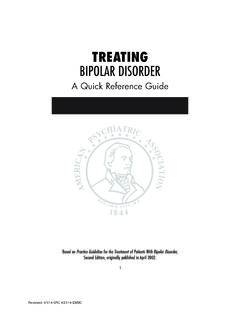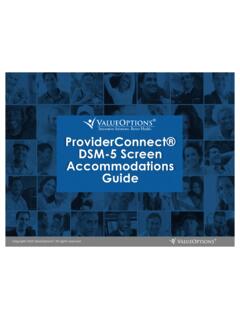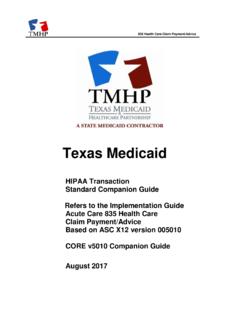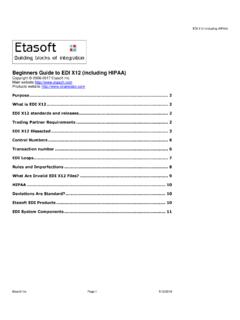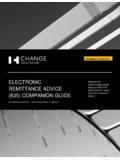Transcription of 837 Health Care Claim Companion Guide …
1 Page 1 Version November 24, 2010 837 Health care Claim Companion Guide professional and Institutional Version November 24, 2010 Page 2 Version November 24, 2010 TABLE OF CONTENTS VERSION CHANGELOG 3 INTRODUCTION 4 PURPOSE 4 SPECIAL CONSIDERATIONS 5 Inbound Transactions Supported 5 Response Transactions Supported 5 Delimiters Supported 5 Maximum Limitations 5 Telecommunication Specifications 6 Compliance Testing Specifications 6 Trading Partner Acceptance Testing Specifications 7 National Provider Identifier Specification 8 Provider Billing Requirements 8 Billing Agent Scenario: ( professional or Institutional Claims) 9 Provider Group Scenario: ( professional Claims) 9 Individual Provider Scenario: ( professional Claims) 9 Service Facility Scenario: (Institutional Claims) 9 INTERCHANGE CONTROL HEADER SPECIFICATIONS 11 INTERCHANGE CONTROL TRAILER SPECIFICATIONS 14 FUNCTIONAL GROUP HEADER SPECIFICATIONS 15 FUNCTIONAL GROUP TRAILER SPECIFICATIONS 17 837 professional Claim TRANSACTION SPECIFICATIONS 18 837 INSTITUTIONAL Claim TRANSACTION SPECIFICATIONS 26 Page 3 Version November 24, 2010 Version Original Published April 1, 2003 Version Published April 24, 2003 Changes were made to the Provider Secondary Reference Identification Qualifiers on the following.
2 Loop 2010AA, REF01 and REF02 Loop 2010AB, REF01 and REF02 Loop 2310B, REF01 Loop 2010AB, REF01 and REF02 Loop 2310A, REF01 and REF02 Change was made to the 837 professional Identification Code Qualifier, Loop 2310A, NM108 Change was made to the 837 Institutional Claim Frequency Type Code, Loop 2300, CLM05-3 Version Published May 12, 2003 Changes were made to the Functional Group Header Version/Release Industry ID Code on GS08 Referring Provider Secondary Identification segment was added on Loop 2310A, REF01 and REF02 Changes were made to the Rendering Provider Secondary Reference Identification Qualifiers on Loop 2310B, REF01 and REF02 Version Published May 13, 2003 Changes were made to the Interchange ID Qualifier and the Interchange Receiver ID on ISA07 and ISA08 Changes were made to the Receiver Primary Identifier on NM109 Changes were made to the Payer Identifier on NM109 Version Published June 18, 2003 Changes were made to the Telecommunication Specifications. Version Published October 7, 2003 Added rows to indicate comments regarding procedure modifiers.
3 Version Published November 12, 2003 Since the 837 professional Implementation Guide Addendum indicates no valid codes to be used for the field Claim Frequency Type Code , the requirements for CLM05-3 have been removed. The indication for original Claim number for resubmitted claims has also been modified so that there is no reference to CLM05-3. Version Published November 24, 2003 Instructions to provide whole number unit values were added to the document. Version Published May 18, 2005 Removed requirements to provide a date span (RD8) at the Claim line level (2400 loop) for institutional claims has been removed. Date span or a single date may be provided on the Claim line. Removed: Use RD8 to specify a range of dates. The from and thru service dates should be sent for each service line. Version Published August 8, 2006 New logo added. Text reformatted. URLs verified and updated Updated EDI Test file requirements for all users using both EDI Claims Link and 3rd party software Version Published April 23, 2007 Instructions added for the National Provider Identifier (NPI) requirements Version Published September 22, 2008 Updated Provider requirements to remove references for legacy numbers.
4 Version Published November 20, 2008 Added required Dx segment. Version Published September 17, 2009 Added requirement for Service Location on all professional and Institutional claims Added 2310D, 2310E, and 2310A to billing requirements and scenarios Added COB fields Version Published November 24, 2010 Added maximum value for ISA/IEA envelope Page 4 Version November 24, 2010 INTRODUCTION In an effort to reduce the administrative costs of Health care across the nation, the Health Insurance Portability and Accountability Act (HIPAA) was passed in 1996. This legislation requires that Health insurance payers in the United States comply with the electronic data interchange (EDI) standards for Health care , established by the Secretary of Health and Human Services (HHS). For the Health care industry to achieve the potential administrative cost savings with EDI, standard transactions and code sets have been developed and need to be implemented consistently by all organizations involved in the electronic exchange of data.
5 The ANSI X12N 837 Health care Claims transaction implementation guides provide the standardized data requirements to be implemented for all Health care Claim electronic submissions. HIPAA does not require that a provider submit Health care claims electronically. Providers may continue to submit paper claims and receive a paper remittance advice. However, if the provider elects to conduct business electronically, HIPAA does mandate the use of the standard transactions and code sets. PURPOSE The purpose of this document is to provide the information necessary to submit claims/encounters electronically to ValueOptions, Inc. This Companion Guide is to be used in conjunction with the ANSI X12N implementation guides. The information describes specific requirements for processing data within the payer s system. The Companion Guide supplements, but does not contradict or replace any requirements in the implementation Guide . The implementation guides can be obtained from the Washington Publishing Company by calling 1-800-972-4334 or are available for download on their web site at Other important websites: Workgroup for Electronic Data Interchange (WEDI) United States Department of Health and Human Services (DHHS) Centers for Medicare and Medicaid Services (CMS) Designated Standard Maintenance Organizations (DSMO) National Council of Prescription Drug Programs (NCPDP) National Uniform Billing Committee (NUBC) Accredited Standards Committee (ASC X12) Page 5 Version November 24, 2010 SPECIAL CONSIDERATIONS Inbound Transactions Supported This section is intended to identify the type and version of the ASC X12 837 Health care Claim transaction that the Health plan will accept.
6 837 professional Health care Claim - ASC X12N 837 (004010X098A1) 837 Institutional Health care Claim - ASC X12N 837 (004010X096A1) 837 Dental Health care Claim - ASC X12N 837 (004010X097A1) Response Transactions Supported This section is intended to identify the response transactions supported by the Health plan. TA1 Interchange Acknowledgement 997 Functional Acknowledgement 835 Health care Claim Payment Advice - ASC X12N 835 (004010X091A1) Delimiters Supported A delimiter is a character used to separate two data elements or sub-elements, or to terminate a segment. Delimiters are specified in the interchange header segment, ISA. The ISA segment is a 105 byte fixed length record. The data element separator is byte number 4; the component element separator is byte number 105; and the segment terminator is the byte that immediately follows the component element separator. Once specified in the interchange header, delimiters are not to be used in a data element value elsewhere in the transaction.
7 Description Default Delimiter Data element separator * Asterisk Sub-element separator : Colon Segment Terminator ~ Tilde ValueOptions will support these default delimiters or any delimiter specified by the trading partner in the ISA/IEA envelope structure. Maximum Limitations The 837 transaction is designed to transmit one or more claims for each billing provider. The hierarchy of the looping structure is billing provider, subscriber, patient, Claim level, and Claim service line level. Each transaction set contains groups of logically related data in units called segments. The number of times a loop or segment may repeat in the transaction set structure is defined in the implementation Guide . Some of these limitations are explicit, such as: Maximum of 1 ISA/IEA envelope per 837 file The Claim Information loop (2300) is limited to 100 claims per patient. The Service Line loop (2400) is limited to 50 service lines per professional and/or dental Claim , and 999 per institutional Claim .
8 Page 6 Version November 24, 2010 However, some limitations are not explicitly defined. The developers of the implementation Guide recommend that trading partners limit the size of the transaction (ST/SE envelope) to a maximum of 5000 claims per transaction set. The maximum file size is 8MB. The Interchange Control structure (ISA/IEA envelope) will be treated as one file. Each Interchange Control structure may consist of multiple Functional Groups (GS/GE envelopes). ValueOptions requires that the Interchange Control structure is limited to one type of Functional Group, such as 837 Health care Claim and that Institutional and professional functional groups be submitted in separate Interchange Control structures (ISA/IEA envelopes). Note: If submitting both encounter and Claim transactions these too must be sent in separate Interchange Control structures (ISA/IEA envelopes). ValueOptions will validate and accept or reject the entire Interchange Control structure (ISA/IEA envelope).
9 Telecommunication Specifications Trading partners wishing to submit electronic Health care Claims (837 transactions) to ValueOptions must have a valid ValueOptions Submitter ID/Password. If you do not have a Submitter ID you may obtain one by completing the Account Request form available on the ValueOptions website at ValueOptions can accommodate multiple submission methods for the 837 Health care Claim transaction. Please refer to the ETS (Electronic Transport System) Electronic Data Exchange Overview document on the ValueOptions website at for further details. If you have any questions please contact the ValueOptions EDI help desk. E-mail: Telephone: 888-247-9311 (8am 6pm Eastern, Monday Friday) FAX: 866-698-6032 Compliance Testing Specifications The Workgroup for Electronic Data Interchange (WEDI) and the Strategic National Implementation Process (SNIP) have recommended seven types HIPAA compliance testing, these are: 1. Integrity Testing This is testing the basic syntax and integrity of the EDI transmission to include: valid segments, segment order, element attributes, numeric values in numeric data elements, X12 syntax and compliance with X12 rules.
10 2. Requirement Testing This is testing for HIPAA Implementation Guide specific syntax such as repeat counts, qualifiers, codes, elements and segments. Also testing for required or intra-segment situational data elements and non-medical code sets whose values are noted in the Guide via a code list or table. 3. Balance Testing This is testing the transaction for balanced totals, financial balancing of claims or remittance advice and balancing of summary fields. 4. Situational Testing This is testing of inter-segment situations and validation of situational fields based on rules in the Implementation Guide . 5. External Code Set Testing This is testing of external code sets and tables specified within the Implementation Guide . This testing not only validates the code value but also verifies that the usage is appropriate for the particular transaction. Page 7 Version November 24, 2010 6. Product Type or Line of Service Testing This is testing that the segments and elements required for certain Health care services are present and formatted correctly.
